Lespedeza frutescens
| Lespedeza frutescens | |
|---|---|

| |
| Photo and permission by Beverly Walters, © 2016 University of Michigan Herbarium Michigan Flora Online | |
| Scientific classification | |
| Kingdom: | Plantae |
| Division: | Magnoliophyta - Flowering plants |
| Class: | Magnoliopsida – Dicotyledons |
| Order: | Fabales |
| Family: | Fabaceae ⁄ Leguminosae |
| Genus: | Lespedeza |
| Species: | L. frutescens |
| Binomial name | |
| Lespedeza frutescens (L.) Hornem. | |

| |
| Natural range of Lespedeza frutescens from USDA NRCS Plants Database. | |
Common names: Shrubby lespedeza, violet lespedeza[1]
Contents
Taxonomic notes
Synonyms: Lespedeza violacea (Linnaeus) Persoon (misapplied)[1]
Varieties: none[1]
Description
“Annual or perennial herbs or shrubs. Leaves pinnately 3-foliate; leaflets entire, stipellate; stipules persistent, setaceous to ovate-lanceolate. Inflorescence usually few-to-many-flowered, loose to compact, sessile to long-pedunculate, axillary or terminal, spicate, racemose, capitate, or rarely paniculate cluster; pedicels subtended by a bract and with a pair of inconspicuous bractlets immediately beneath the flower. Both apetalous (cleistogamous) and petaliferous (Chasmogamous) flowers present in most species, but the apetalous flower are more readily detected and more abundant in some species than others. Calyx persistent in fruit, the tube campanulate to cylindric with 5 nearly equal lobes or the upper 2 partly united and shorter; corolla papilionaceous, violet, purplish, roseate, yellow or whitish; stamens diadelphous, 9 and 1. Legume 1-seeded, indehiscent, sessile or stalked, flattened, elliptic, ovate, or orbicular.” [2]
"Erect perennial with stems 2-10 dm tall, sparely to densely strigillose or more rarely ascendent-puberulent, becoming glabrate or nearly so below. Leaflets oblong to oblong-elliptic or less commonly or in the uppermost leaves elliptic, ovate, obovate or even suborbicular, the principal leaflets 1.5-4 cm long, those of the upper leaves and of the lateral branches 0.5-2 cm long, usually glabrate to sparsely strigillose or appressed short-pubescent beneath; stipules narrowly linear-subulate to setaceous, mostly less than 4 mm long. Flowers are borne in dense, sessile to short-peduncles and axes sparsely to densely strigillose; pedicels of Chasmogamous flowers 1-4 mm long, those of the cleistogamous flowers 0.5-1 mm long. Calyx appressed short-pubescent to strigillose; petals purplish, wings longer than keel and nearly as long as standard. Legume reticulate, sparsely to densely strigillose, elliptic to almost orbicular, 3-7 mm long." [2]
Distribution
This species ranges north in Massachusetts and New York, west to Michigan, Wisconsin, Iowa, and Kansas, then south to the Florida Panhandle, Alabama, Mississippi, Arizona, and Texas.[1]
Ecology
Habitat
It is found in the herbaceous cover in young Arkansas loblolly pine plantations.[3] Occurs in open, well-drained sandy loam soil type habitats such as oak-pine woods, mature longleaf pine-wiregrass stand, hardwood forests, borders of upland pines, and areas that have frequent fires. [4] Is also found in human-disturbed sites such as dry, gravelly roadsides and old fields. [4]
Associated species include Triplasis americana, Agalinis purpurea, Carya, Quercus stellata, Pinus palustris, and Aristida stricta.[4]
Phenology
L. frutescens flowers from July through September and fruits from October through November.[1] Herbivory and toxicology=== Lespedeza frutescens has been observed to host the leafcutting bee Anthidiellum notatum (family Megachilidae).[5]
Conservation, cultivation, and restoration
Cultural use
Photo Gallery
References and notes
- ↑ 1.0 1.1 1.2 1.3 1.4 Weakley, A.S. 2020. Flora of the Southeastern United States. Edition of 20 October 2020. University of North Carolina at Chapel Hill, Chapel Hill, North Carolina.
- ↑ 2.0 2.1 Radford, Albert E., Harry E. Ahles, and C. Ritchie Bell. Manual of the Vascular Flora of the Carolinas. 1964, 1968. The University of North Carolina Press. 613-7. Print.
- ↑ Sweeney, J. M., C. R. Wenger, et al. (1981). Bobwhite quail food in young Arkansas loblolly pine plantations. Arkansas Experiment Station bulletin 852. Fayetteville, AR, University of Arkansas, Division of Agriculture, Agricultural Experiment Station.
- ↑ 4.0 4.1 4.2 Florida State University Robert K. Godfrey Herbarium database. URL: http://herbarium.bio.fsu.edu. Last accessed: February 2016. Collectors: Robert K. Godfrey, A.F. Clewell, James R. Burkhalter, Roy Komarek, Norman E. Hill, Loran C. Anderson, H.R. Reed, and Sidney McDaniel. States and Counties: Florida: Leon, Liberty, Okaloosa, Santa Rosa. Georgia: Chattooga, Grady, Haralson, Heard, Thomas, Walker. Mississippi: Choctaw, Kemper, Pearl River.
- ↑ Discoverlife.org [1]